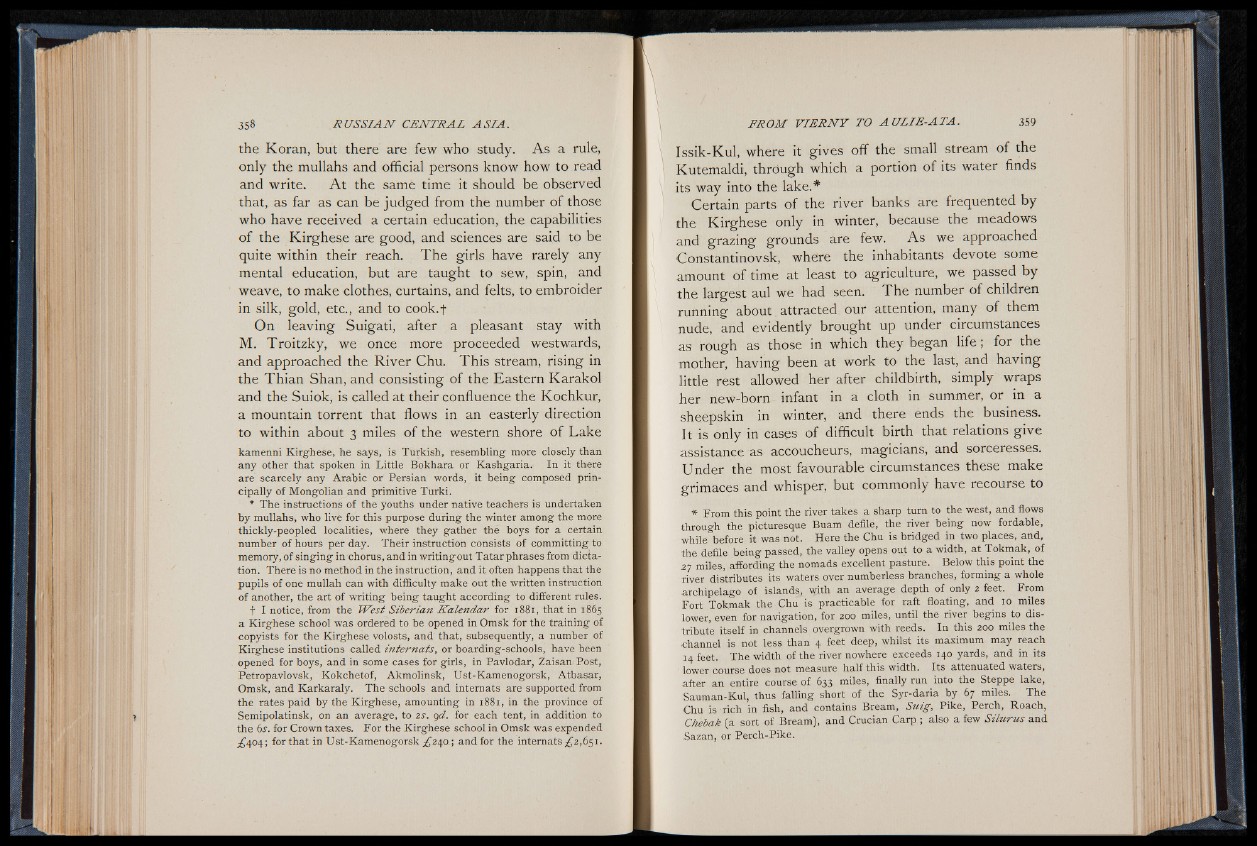
the Koran, but there are few who study. As a rule,
only the mullahs and official persons know how to read
and write. A t the same time it should be observed
that, as far as can be judged from the number of those
who have received a certain education, the capabilities
of the Kirghese are good, and sciences are said to be
quite within their reach. The girls have rarely any
mental education, but are taught to sew, spin, and
weave, to make clothes, curtains, and felts, to embroider
in silk, gold, etc., and to cook.f
On leaving Suigati, after a pleasant stay with
M. Troitzky, we once more proceeded westwards,
and approached the River Chu. This stream, rising in
the Thian Shan, and consisting of the Eastern Karakol
and the Suiok, is called at their confluence the Kochkur,
a mountain torrent that flows in an easterly direction
to within about 3 miles of the western shore of Lake
kamenni Kirghese, he says, is Turkish, resembling more closely than
any other that spoken in Little Bokhara or Kashgaria. In it there
are scarcely any Arabic or Persian words, it being composed principally
of Mongolian and primitive Turki.
* The instructions of the youths under native teachers is undertaken
by mullahs, who live for this purpose during the winter among the more
thickly-peopled localities, where they gather the boys for a certain
number of hours per day. Their instruction consists of committing to
memory, of singing in chorus, and in writing out Tatar phrases from dictation.
There is no method in the instruction, and it often happens that the
pupils of one mullah can with difficulty make out the written instruction
of another, the art of writing being taught according to different rules.
f I notice, from the West Siberian Kalendar for 1881, that in 1865
a Kirghese school was ordered to be opened in Omsk for the training of
copyists for the Kirghese volosts, and that, subsequently, a number of
Kirghese institutions called internats, or boarding-schools, have been
opened for boys, and in some cases for girls, in Pavlodar, Zaisan Post,
Petropavlovsk, Kokchetof, Akmolinsk, Ust-Kamenogorsk, Atbasar,
Omsk, and Karkaraly. The schools and internats are supported from
the rates paid by the Kirghese, amounting in 1881, in the province of
Semipolatinsk, on an average, to 2s. gd. for each tent, in addition to
the 6s. for Crown taxes. For the Kirghese school in Omsk was expended
^404; for that in Ust-Kamenogorsk ¿£2404 and for the internats ^2,651.
Issik-Kul, where it gives off the small stream of the
Kutemaldi, thrdugh which a portion of its water finds
its way into the lake.*
Certain parts of the river banks are frequented by
the Kirghese only in winter, because the meadows
and grazing grounds are few. As we approached
Constantinovsk, where the inhabitants devote some
amount of time at least to agriculture, we passed by
the largest aul we had seen. The number of children
running about. attracted our attention, many of them
nude, and evidently brought up under circumstances
as rough as those in which they began life ; for the
mother, having been at work to the last, and having
little rest allowed her after childbirth, simply wraps
her new-born infant in a cloth in summer, or in a
sheepskin in winter, and there ends the business.
It is only in cases of difficult birth that relations give
assistance as accoucheurs, magicians, and sorceresses.
Under the most favourable circumstances these make
grimaces and whisper, but commonly have recourse to
* From this point the river takes a sharp turn to the west, and flows
through the picturesque Buam defile, the river being now fordable,
while before it was not. Here the Chu is bridged in two places, and,
the defile being passed, the valley opens out to a width, at Tokmak, of
27 miles, affording the nomads excellent pasture. Below this point the
river distributes its waters over numberless branches, forming a whole
archipelago of islands, with an average depth of only 2 feet. From
Fort Tokmak the Chu is practicable for raft floating, and 10 miles
lower, even for navigation, for 200 miles, until the river begins to distribute
itself in channels overgrown with reeds. In this 200 miles the
channel is not less than 4 feet deep, whilst its maximum may reach
14 feet. The width of the river nowhere exceeds 140 yards, and in its
lower course does not measure half this width. Its attenuated waters,
after an entire course of 633 miles, finally run into the Steppe lake,
Sauman-Kul, thus falling short of the Syr-daria by 67 miles. The
Chu is rich in fish, and contains Bream, Suig, Pike, Perch, Roach,
Chebak (a sort of Bream), and Crucian Carp ; also a few Silurus and
Sazan, or Perch-Pike.